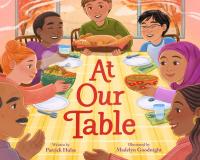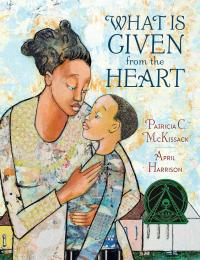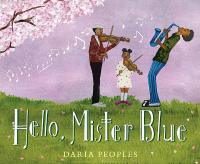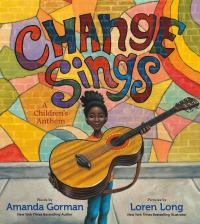
There are countless ways we celebrate and give to others on Thanksgiving. The goodness we share lasts the rest of the year — and sometimes for a lifetime. From joyful preparation of food, to quiet reflection honoring farmers and Native communities, to cherished moments of laughter with friends or family … there is always room for making more memories together.
At Our Table

In this vibrant tribute to Rock Your Mocs Day, observed yearly on November 15, author Laurel Goodluck (Mandan, Hidatsa, and Tsimshian) and artist Madelyn Goodnight (Chickasaw) celebrate the joy and power of wearing moccasins — and the Native pride that comes with them.
Rock Your Mocs

Look around … art is everywhere! Art can be everything from the family photograph to the chair in your living room. This exploration encourages readers to discover art from around the world and in their own backyard. “Circles of art” begin with self, expanding out to the cosmos. Thoughtfully presented and attractively formatted, this book can be enjoyed many times over.
Art All Around Us: A Kid’s Guide to Finding Art in Everyday Life

Are you Métis like me? A group of children of Métis descent share and explore all the ways they celebrate and experience their heritage — enjoying traditional foods like bannock bread and Saskatoon berries; crafting with beads; sharing stories, dance, music and songs. Each child shares a different way they enjoy honoring their backgrounds and weaving parts of the rich tapestry that makes up Métis culture. One child, though, has grown up disconnected from their history, and can’t join in with the others in the same way. But they soon see it’s never too late to learn, celebrate or become a part of a community in which Métis and non-Métis alike can discover the richness of an often-overlooked culture.
Métis Like Me

Travel across the U.S. and meet some kids where they live. This carefully crafted and well-researched introduction introduces individuals who live in different places but share a great deal in common. A companion volume to the author’s This is How We Do It: One Day in the Lives of Seven Kids from Around the World (opens in a new window).
All About U.S.: A Look at the Lives of 50 Real Kids from Across the United States

From an abandoned empty lot that Nevaeh called haunted, Mr. Tony and the kids from PS175 transform it into a lush garden that produces food to share. Childlike illustrations complement the gradual transformation. An author’s note includes information about Harlem Grown, the community nonprofit, as well as steps to start a garden.
Saturdays at Harlem Grown: How One Big Idea Transformed a Neighborhood

A tender tale of a boy and his grandfather taking their produce to sell at the last market stand. When the older man is too tired to go, the boy delivers the produce to their regular customers who in turn, bring a meal made with the produce to the farm. Descriptive language is enhanced by colorful, effective illustration created by handmade stamps.
The Last Stand

Art’s dad wakes up still feeling sluggish from his cold, so father and son go on a hunt to make a cold-fighting juice. With a bit of help from the community, a tasty, healthy juice starts dad’s recovery. Realistic illustrations complement the contemporary story which includes a juice recipe. Also available in Spanish: Jugo Fresco (opens in a new window), translated by Rita E. Urquijo-Ruiz.
Fresh Juice

Young children are invited to a powwow in this 1-to-10 counting board book — beginning with one car traveling to the powwow to 10 tribal citizens enjoying the celebration. The indigenous author and illustrator team that wrote Powwow Day (for slightly older readers) now introduce younger readers to the powwow tradition.
On Powwow Day

The golden puppy joins his girl while she works in the community garden. The young dog winds up being a helpful companion to others also working there in this short, easy to read addition to the series.
Biscuit and Friends Visit the Community Garden

“Misery loves company,” Mama says to James Otis. It’s been a rough couple of months for them, but Mama says as long as they have their health and strength, they’re blessed. One Sunday before Valentine’s Day, Reverend Dennis makes an announcement during the service — the Temples have lost everything in a fire, and the church is collecting anything that might be useful to them. James thinks hard about what he can add to the Temple’s “”love box,”” but what does he have worth giving? A touching, powerful tale of compassion and reminds us all that what is given from the heart, reaches the heart.
What Is Given from the Heart

Inspired by the author’s family on the North Carolina coast during Jim Crow, this touching portrait introduces twins James Henry and Hattie and the mysterious trauma that made James Henry unable to leave the security of his home. The story unfolds slowly in accessible free verse to its satisfying resolution.
Once in a Blue Moon

Two books from a Little Free Library hold the secret of a town’s long hidden mystery. Told from different points of view — a boy named Evan, Al (a ghost librarian), and a handsome orange cat called Mortimer — reveal the secret behind the town’s puzzling history in this twisty, satisfying tale.
The Lost Library

An indigenous boy must travel up a mountain to collect obsidian for flint knapping, a trek from which his brothers did not return. There he meets a golden eagle, actually a god named Savik. This is a beautifully told and handsomely illustrated story of the origin of the Iñupiaq messenger feast celebrated by native Alaskans.
Eagle Drums

A girl’s time with her grandfather, Papa, is always special. One day while playing music together in the park, they meet one of Papa’s old friends. Mr. Blue lives outside which concerns the girl. Ultimately, they invite Mr. Blue home for a meal and a memorable musical jam session. Textured illustrations are detailed, creating a gentle tone that accompanies the moving story.
Hello, Mister Blue

Take a brief tour of Chinatown and its sites including a New Year’s dragon, presented in realistic illustrations accompanied by single words in both English and Chinese (both transliterated with pronunciation).
Welcome to Chinatown

This wordless picture book with Baker’s characteristically beautifully detailed collage illustrations conveys a subtle message about how we can bring positive change to our communities. Every double-page spread is a view through the same window, a view that changes over a generation. Children can share what they think is happening to the neighborhood based on the illustrations.
Home

“I can hear change humming/ In its loudest, proudest song./ I don’t fear change coming,/ And so I sing along.” As a young girl leads a cast of characters on a musical journey, they learn that they have the power to make changes — big or small — in the world, in their communities, and in most importantly, in themselves. Lyrical text and rhythmic illustrations is a call to action for everyone to use their abilities to make a difference.
Change Sings: A Children’s Anthem

In this picture book about voting and elections, the students of Stanton Elementary School learn how we can find — and use — our voices for change. Every two years, on the first Tuesday of November, the school closes for the day so that it can transform itself into a polling station. People can come from all over to vote for the people who will make laws for the country. The students might be too young to vote themselves, but that doesn’t mean they can’t encourage their parents, friends, and family to vote! After all, voting is how this country sees change — and by voting today, we can inspire tomorrow’s voters to change the future.
Vote for Our Future

Based on the true story of a boy in Brooklyn who became neighbors and friends with his hero, Jackie Robinson. In 1948, when eight-year-old Steve learns that his African American baseball hero Jackie Robinson — who broke the color barrier in the sport the previous year — will be the new next-door neighbor in his all-Jewish Brooklyn neighborhood, he gains knowledge about respect, friendship, and unity.
The Hero Two Doors Down

When you meet someone for the first time, they might ask, “Who are your people?” and “Where are you from?” This book depicts children from the African Diaspora, and invites young readers to reflect on who they are and where their ancestors came from. The book opens on a scene of a father sharing with his children the importance of their heritage, their lineage, and how far they have come in overcoming obstacles from the time of their ancestors to the present.
Who Are Your People?

Carnegie Hall opened in 1891 to become the site in New York where everyone from Duke Ellington to Bob Dylan performed. Stern was not only a violin virtuoso, but he was also an effective community organizer who worked tirelessly to save the grand hall in the face of great opposition. His tenacity and music swirl throughout the lively illustrations and carefully crafted language. Additional information is appended.
The Greatest Song of All: How Isaac Stern United the World to Save Carnegie Hall

How a small black-and-white kitten brings a community together is told through gentle illustration and a gently rhyming, cumulative text. Richly-hued illustrations depict a diverse neighborhood whose residents come together to help a small kitten. The satisfying book is sure to make a heartwarming read aloud.
This Story Is Not About a Kitten

A loving celebration of school and all it may signify: work and play, creativity and trust, and a supportive community that extends beyond walls. A school isn’t just a building — it is all the people who work and learn together. It is a place for discovery and asking questions. A place for sharing, for helping, and for community.
